

Jean Nocret (December 1615/17, Nancy- November 1672, Paris) was a French painter who is best known for his portraits of the French royal family. Many portraits of uncertain origin have been attributed to him.


Jean Nocret (December 1615/17, Nancy- November 1672, Paris) was a French painter who is best known for his portraits of the French royal family. Many portraits of uncertain origin have been attributed to him.
He was a student of Jean LeClerc. Later, he traveled to Rome, where he met Nicolas Poussin and did some work for Poussin's patron, Paul Fréart de Chantelou. [1] Poussin, however, thought that Nocret was a pretentious young man and complained that he left his work unfinished because he had received better offers.
Nocret returned to Paris in 1644. Five years later, he managed to obtain an appointment as painter to King Louis XIV and Gaston, Duke of Orléans. He also served as the King's valet de chambre. In 1657, he accompanied the Bishop of Comminges on a diplomatic mission to Portugal, and executed portraits of the Portuguese Royal Family. [2] Back in Paris, in 1660, he was commissioned by the new Duke of Orléans to decorate the interiors of the Château de Saint-Cloud with scenes from Greek mythology. The Château was later destroyed, during the Franco-Prussian War. Three years later, his painting of "The Repentance of Saint Peter" earned him a place in the Académie royale de peinture et de sculpture. He became a Professor there in 1664. [1]
Between 1666 and 1669, he decorated the Queen's apartments at the Tuileries, under the direction of Charles Le Brun. These decorations also disappeared during the Franco-Prussian War, when the Tuileries were burned. Most of them depicted scenes relating to the goddess Minerva.
His son, Jean-Charles (1648-1719), was also a portraitist, but did history painting as well. After his father's death, he was called upon to decorate the Queen's apartments at Versailles. [1]
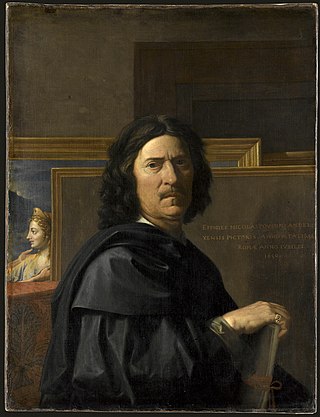
Nicolas Poussin was a French painter who was a leading painter of the classical French Baroque style, although he spent most of his working life in Rome. Most of his works were on religious and mythological subjects painted for a small group of Italian and French collectors. He returned to Paris for a brief period to serve as First Painter to the King under Louis XIII and Cardinal Richelieu, but soon returned to Rome and resumed his more traditional themes. In his later years he gave growing prominence to the landscape in his paintings. His work is characterized by clarity, logic, and order, and favors line over color. Until the 20th century he remained a major inspiration for such classically-oriented artists as Jacques-Louis David, Jean-Auguste-Dominique Ingres and Paul Cézanne.

Jacint Rigau-Ros i Serra, known in French as Hyacinthe Rigaud, was a Spanish-French baroque painter most famous for his portraits of Louis XIV and other members of the French nobility.
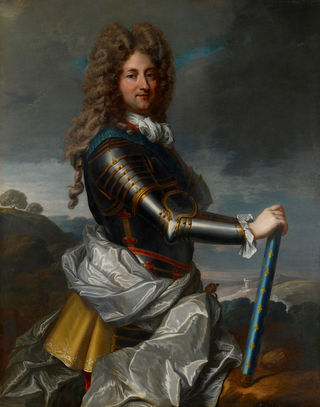
Philippe II, Duke of Orléans, was a French prince, soldier, and statesman who served as Regent of the Kingdom of France from 1715 to 1723. He is referred to in French as le Régent. He was the son of Monsieur Philippe I, Duke of Orleans, and Madame Elisabeth Charlotte, Duchess of Orléans. Born at his father's palace at Saint-Cloud, he was known from birth by the title of Duke of Chartres.

Palace of Fontainebleau, located 55 kilometers southeast of the center of Paris, in the commune of Fontainebleau, is one of the largest French royal châteaux. It served as a hunting lodge and summer residence for many of the French monarchs, beginning with Louis VII. Francis I, Henry II, Louis-Philippe, Napoleon Bonaparte and Napoleon III. Though the monarchs only resided there for a few months of the year, they gradually transformed it into a genuine palace, filled with art and decoration. It became a national museum in 1927 and was designated a UNESCO World Heritage Site in 1981 for its unique architecture and historical importance.

Blois is a commune and the capital city of Loir-et-Cher department, in Centre-Val de Loire, France, on the banks of the lower Loire river between Orléans and Tours.

The Régence was the period in French history between 1715 and 1723 when King Louis XV was considered a minor and the country was instead governed by Philippe d'Orléans as prince regent.

The Tuileries Palace was a royal and imperial palace in Paris which stood on the right bank of the Seine, directly in front of the Louvre. It was the Parisian residence of most French monarchs, from Henry IV to Napoleon III, until it was burned by the Paris Commune in 1871.
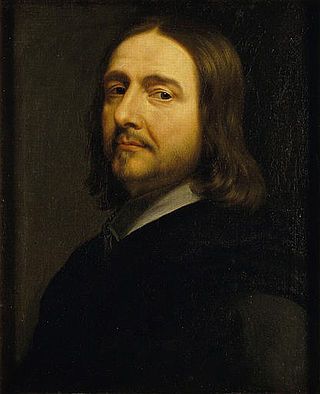
Philippe de Champaigne was a Brabançon-born French Baroque era painter, a major exponent of the French school. He was a founding member of the Académie royale de peinture et de sculpture in Paris, the premier art institution in the Kingdom of France in the eighteenth century.
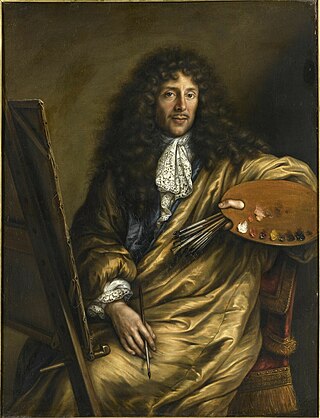
Noël Coypel was a French painter, and was also called Coypel le Poussin, because he was heavily influenced by Poussin.

The Hall of Mirrors is a grand Baroque style gallery and one of the most emblematic rooms in the royal Palace of Versailles near Paris, France. The grandiose ensemble of the hall and its adjoining salons was intended to illustrate the power of the absolutist monarch Louis XIV. Located on the first floor of the palace's central body, it faces west towards the Palace Gardens. The Hall of Mirrors has been the scene of events of great historic significance, including the Proclamation of the German Empire and the signing of the Treaty of Versailles.

Adam Frans van der Meulen or Adam-François van der Meulen was a Flemish painter and draughtsman who was particularly known for his scenes of military campaigns and conquests. Van der Meulen also painted portraits, hunting scenes, paintings of chateaux and landscapes. He created designs for prints and cartoons for tapestries.

French art consists of the visual and plastic arts originating from the geographical area of France. Modern France was the main centre for the European art of the Upper Paleolithic, then left many megalithic monuments, and in the Iron Age many of the most impressive finds of early Celtic art. The Gallo-Roman period left a distinctive provincial style of sculpture, and the region around the modern Franco-German border led the empire in the mass production of finely decorated Ancient Roman pottery, which was exported to Italy and elsewhere on a large scale. With Merovingian art the story of French styles as a distinct and influential element in the wider development of the art of Christian Europe begins.

Jean-Baptiste Oudry was a French Rococo painter, engraver, and tapestry designer. He is particularly well known for his naturalistic pictures of animals and his hunt pieces depicting game. His son, Jacques-Charles Oudry, was also a painter.

Château de Meudon, also known as the Royal Castle of Meudon or Imperial Palace of Meudon, is a French castle in Meudon, Hauts-de-Seine. At the edge of a wooded plateau, the castle offers views of Paris and the Seine, as well as of the Chalais valley. Located between Paris and Versailles, in the heart of a hunting reserve, the castle has an ideal topography for large gardens.
"... the most beautiful place in the world, both in its layout and in its location. " - J. F. Blondel, Cours d'Architecture ..., 1773, volume 4, p. 132.

The Château de Saint-Cloud was a château in France, built on a site overlooking the Seine at Saint-Cloud in Hauts-de-Seine, about 5 kilometres west of Paris. On the site of the former palace is the state-owned Parc de Saint-Cloud.

André Le Nôtre, originally rendered as André Le Nostre, was a French landscape architect and the principal gardener of King Louis XIV of France. He was the landscape architect who designed the gardens of the Palace of Versailles; his work represents the height of the French formal garden style, or jardin à la française.
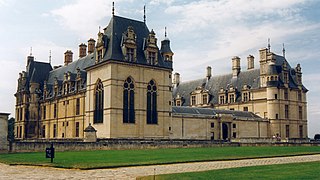
The Château d'Écouen is an historic château in the commune of Écouen, some 20 km north of Paris, France, and a notable example of French Renaissance architecture. Since 1975, it has housed the collections of the Musée national de la Renaissance.
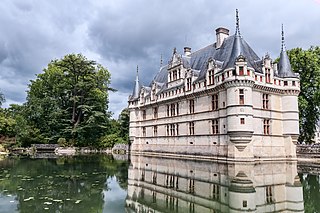
The Château d'Azay-le-Rideau is located in the town of Azay-le-Rideau in the French département of Indre-et-Loire. Built between 1518 and 1527, this château is considered one of the foremost examples of early French renaissance architecture. Set on an island in the middle of the Indre river, this picturesque château has become one of the most popular of the châteaux of the Loire valley.

The Louis XIV style or Louis Quatorze, also called French classicism, was the style of architecture and decorative arts intended to glorify King Louis XIV and his reign. It featured majesty, harmony and regularity. It became the official style during the reign of Louis XIV (1643–1715), imposed upon artists by the newly established Académie royale de peinture et de sculpture and the Académie royale d'architecture. It had an important influence upon the architecture of other European monarchs, from Frederick the Great of Prussia to Peter the Great of Russia. Major architects of the period included François Mansart, Jules Hardouin Mansart, Robert de Cotte, Pierre Le Muet, Claude Perrault, and Louis Le Vau. Major monuments included the Palace of Versailles, the Grand Trianon at Versailles, and the Church of Les Invalides (1675–1691).

Nicolas de Plattemontagne, originally Nicolas Van Plattenberg was a French painter and engraver. His name also appears as La Montagne, Montagne and Montaigne.